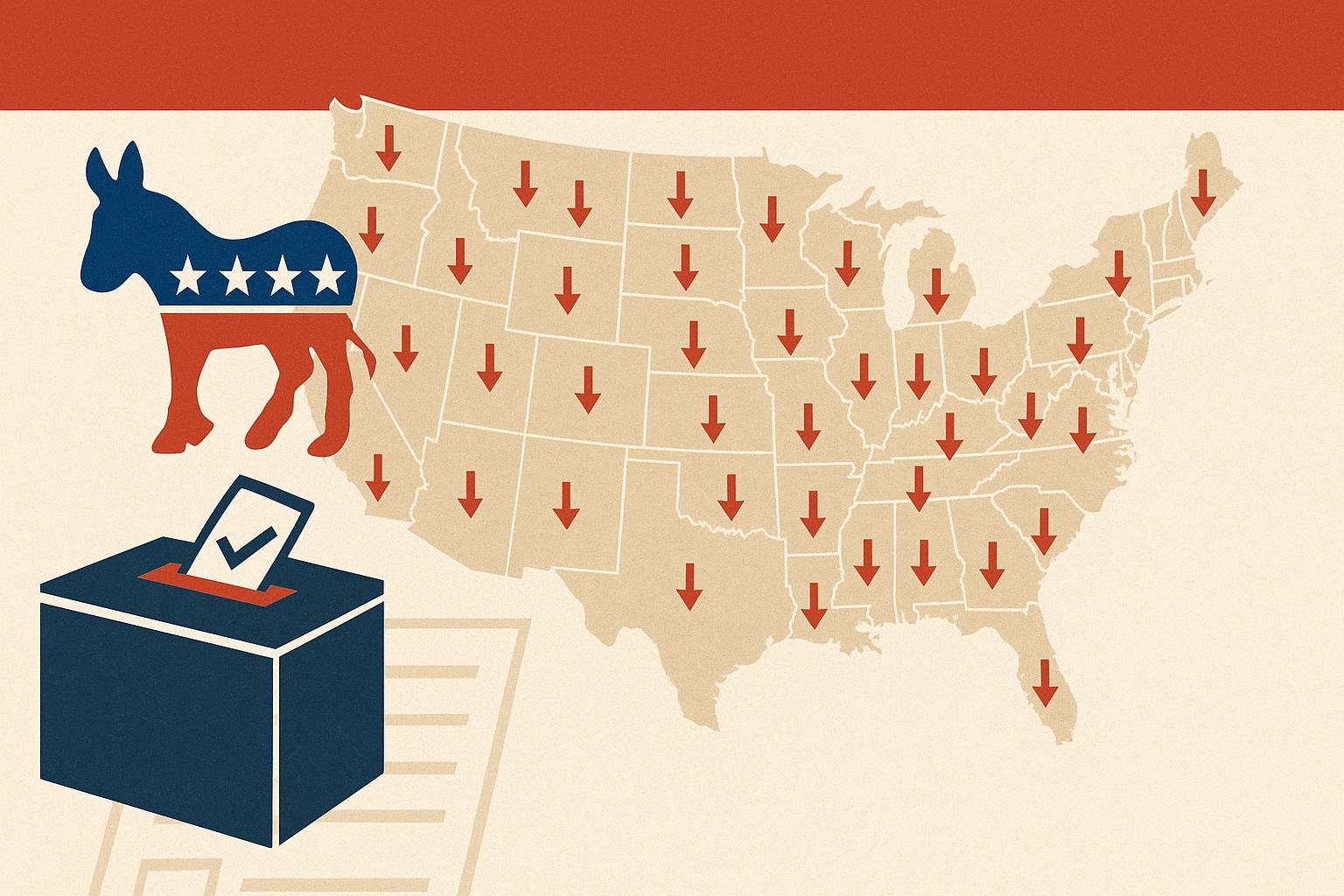For years, Democrats have claimed the changing demographics of America would cement their dominance in national politics. They often point to young voters, urban professionals, and minority communities as the backbone of a permanent progressive majority. But a new analysis of voter registration trends tells a very different story: one of decline, disaffection, and a slow but steady drift of millions of voters away from the Democratic Party and into Republican ranks.
The New York Times recently delved into this topic and found alarms for Democrats across the country. Between the 2020 and 2024 presidential elections, Democrats lost roughly 2.1 million registered voters across 30 states that track party affiliation. Over the same period, Republicans gained about 2.4 million new registered voters. That’s a net swing of nearly 4.5 million registrations toward the GOP—a seismic shift that undercuts the Democrats’ long-cherished “coalition of the future.”
Losses Across Battlegrounds
The most worrisome sign for Democrats is that this isn’t just a blue-state quirk or a regional anomaly—it’s happening across the board, including in must-win swing states.
- North Carolina: Democrats lost more than 115,000 registered voters between 2020 and 2024, while Republicans gained over 140,000. That alone wiped away what had been a meaningful Democratic registration advantage heading into 2020.
- Arizona & Nevada: Once touted as rising Democratic strongholds fueled by young and Latino voters, both states saw erosion in Democratic rolls paired with GOP gains. That shift was enough to tilt margins in 2024.
- Pennsylvania: Already a razor-thin battleground, Democratic voter registration dropped while Republicans added tens of thousands—reshaping the electoral math in one of the most pivotal swing states.
These aren’t small fluctuations—they’re evidence of a sustained realignment. Month after month, year after year, more voters are walking away from the Democratic label.
Blue Strongholds No Longer Safe
The crisis isn’t confined to purple states. Even Democratic bastions are showing troubling signs of erosion.
- California, the heart of the progressive movement, lost more than 680,000 registered Democrats in four years.
- New York, another liberal stronghold, shed over 305,000 Democrats.
While Democrats still hold numerical advantages in these states, the sheer scale of losses suggests deeper dissatisfaction. When even voters in safe blue states abandon the Democratic Party, it’s a signal that the problem is more than geography—it’s about the party’s identity.
The Collapse of New Registrations
Perhaps most alarming for Democrats is the generational picture. In 2018, Democrats captured more than one-third of all new voter registrations nationwide, compared to just 20 percent for Republicans. That advantage has now evaporated.
By 2024, Republicans claimed 29 percent of all new registrations, while Democrats managed just 26 percent. In other words, the GOP is now outpacing Democrats in winning over new voters—a reversal of one of the Democrats’ most reliable trends of the past two decades.
This undermines the party’s argument that demographic change alone will secure future dominance. Younger voters, Latinos, and other fast-growing groups are not lining up in the numbers Democrats once assumed. Many are shifting toward independence—or directly into Republican ranks.
Why the Exodus?
So what’s behind the Democratic decline? Conservative analysts point to a combination of factors:
- Messaging Disconnect: Democrats spend more time attacking Republicans than articulating a clear vision for working families. Voters notice the lack of solutions on inflation, crime, and border security.
- Cultural Overreach: From aggressive climate mandates to identity-driven politics, the Democratic Party increasingly appears out of touch with everyday Americans.
- Economic Realities: With housing costs, grocery bills, and energy prices climbing, many voters—especially blue-collar and minority households—feel the Democratic agenda has worsened rather than improved their daily lives.
- Failure to Retain Core Voters: Once-reliable blocs like Hispanic men and younger voters are now shifting rightward, showing more interest in jobs, opportunity, and security than in progressive social crusades.
Even Democratic strategists privately admit they face serious headwinds. Some warn that unless the party retools its message, its long-term brand could erode beyond repair.
What It Means for the Future
The implications of this registration crisis are profound. Voter registration isn’t just a bureaucratic detail—it’s the foundation of turnout, mobilization, and long-term political identity. When millions of voters switch registration or stop identifying with a party, it changes the structure of the electorate itself.
For Republicans, this is a sign that their investment in grassroots organizing, community outreach, and clear messaging is paying off. For Democrats, it’s a wake-up call. No amount of celebrity endorsements, campus rallies, or social media campaigning can cover for the hard numbers.
As one analyst bluntly put it: “There is no silver lining or cavalry coming across the hill… month after month, year after year, the Democrats’ base is shrinking.”
If these trends continue, Democrats face not just a difficult midterm cycle, but a structural disadvantage heading into the 2028 presidential race. Once thought to hold an unstoppable demographic edge, the party now risks becoming a minority coalition in both registration and enthusiasm.
Bottom Line
The numbers don’t lie: Democrats are losing ground where it matters most—at the voter registration level. The party that once saw itself as the future now finds itself struggling to hold its own base. Meanwhile, Republicans are gaining momentum, expanding their coalition, and reshaping the American electorate.
If Democrats can’t reconnect with everyday voters and articulate a message that resonates beyond progressive enclaves, they risk not just temporary setbacks but a generational decline. The crisis is real, and unless Democrats change course, the registration rolls of America may soon tell the story of a party that lost touch with the people it claimed to represent.
